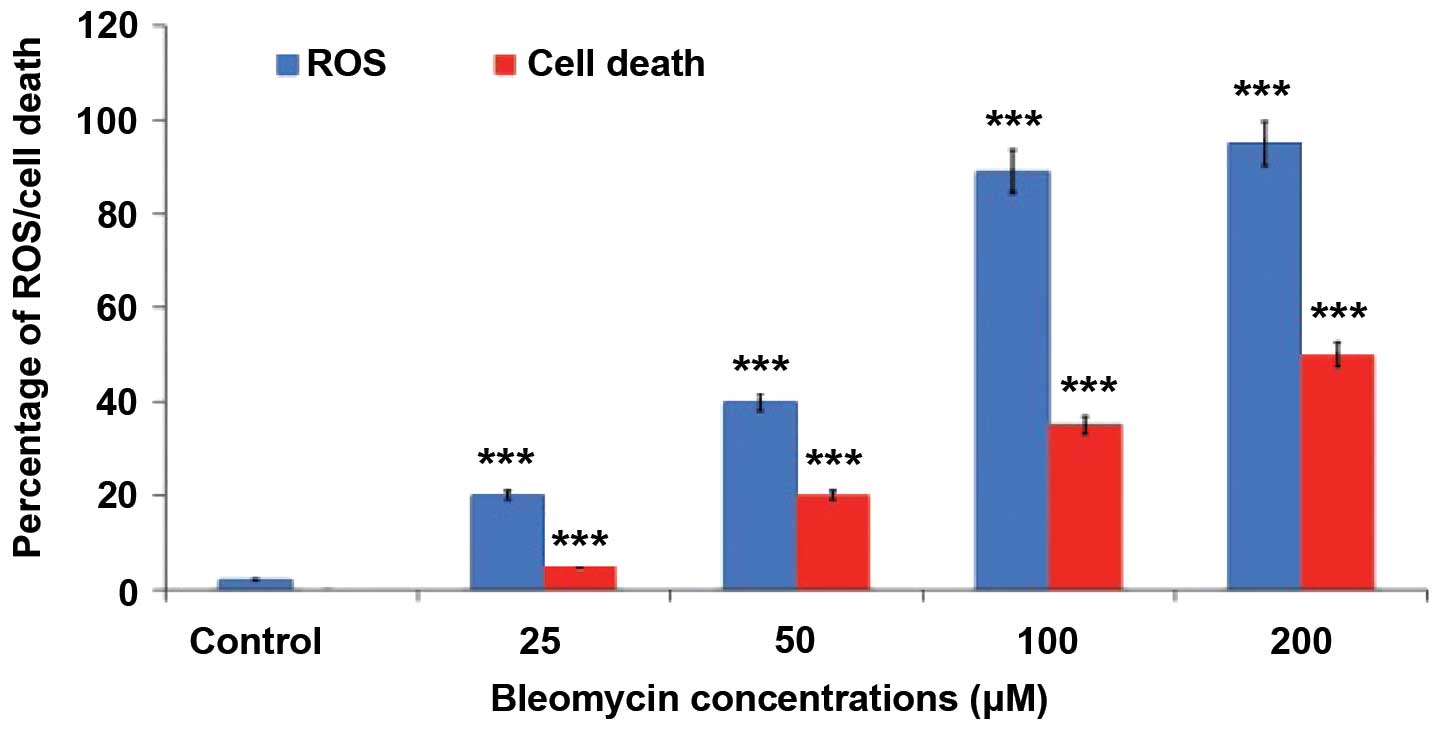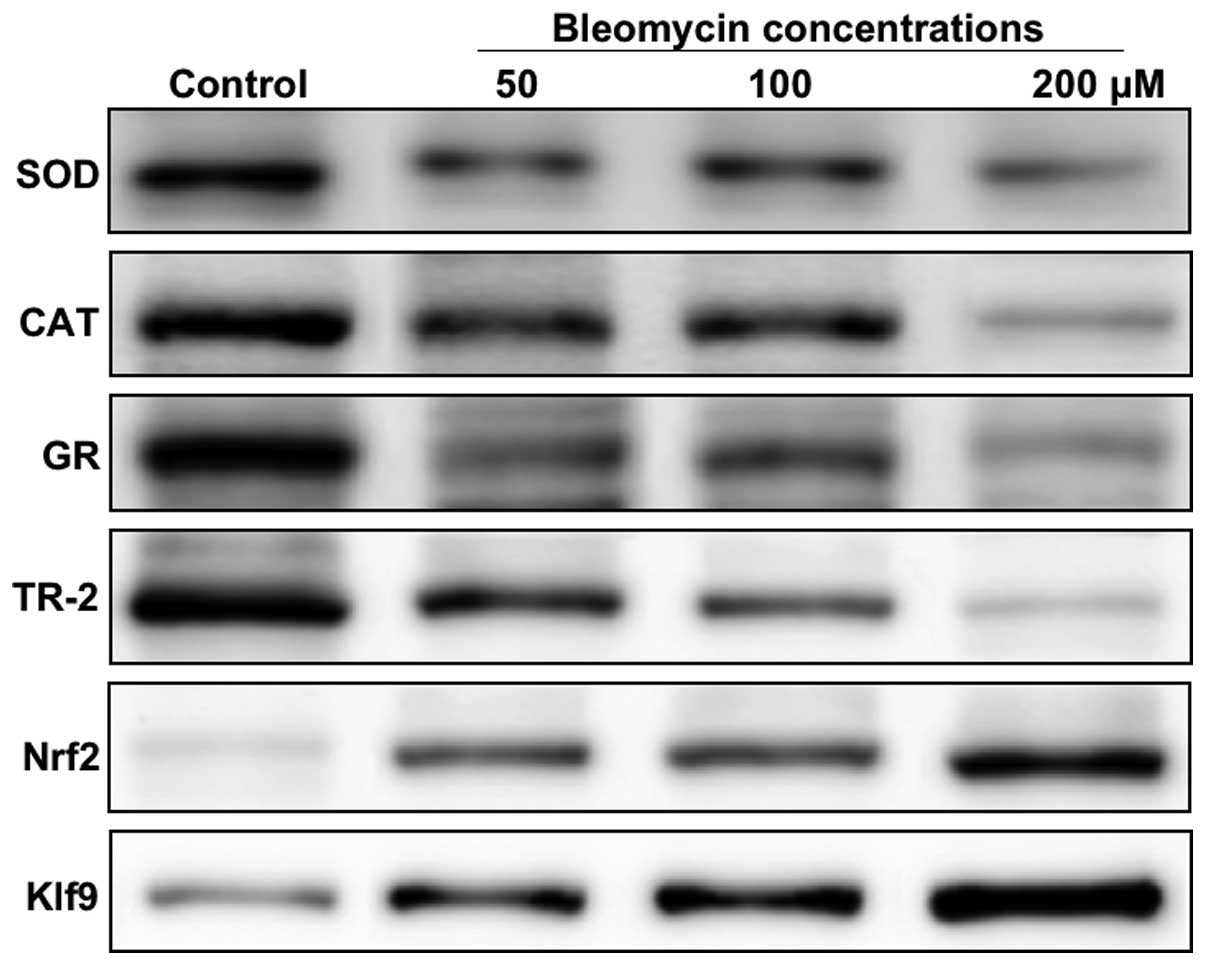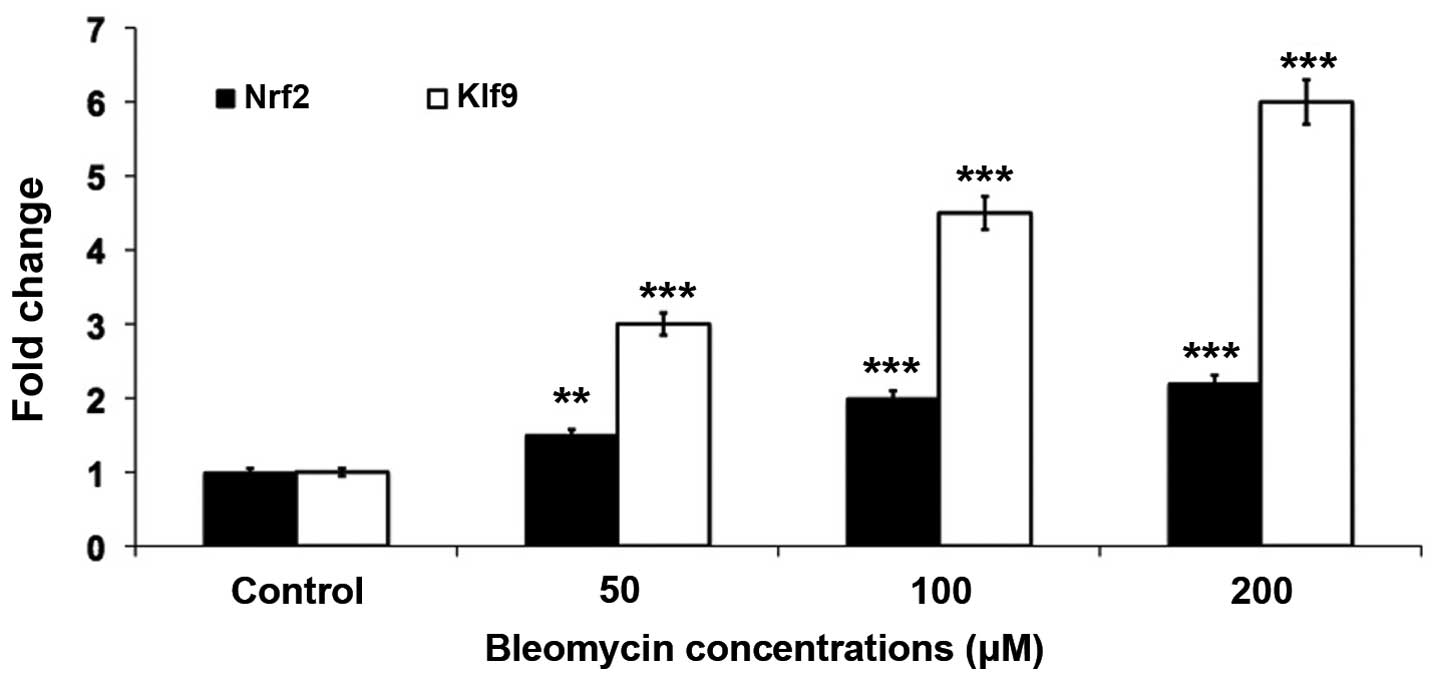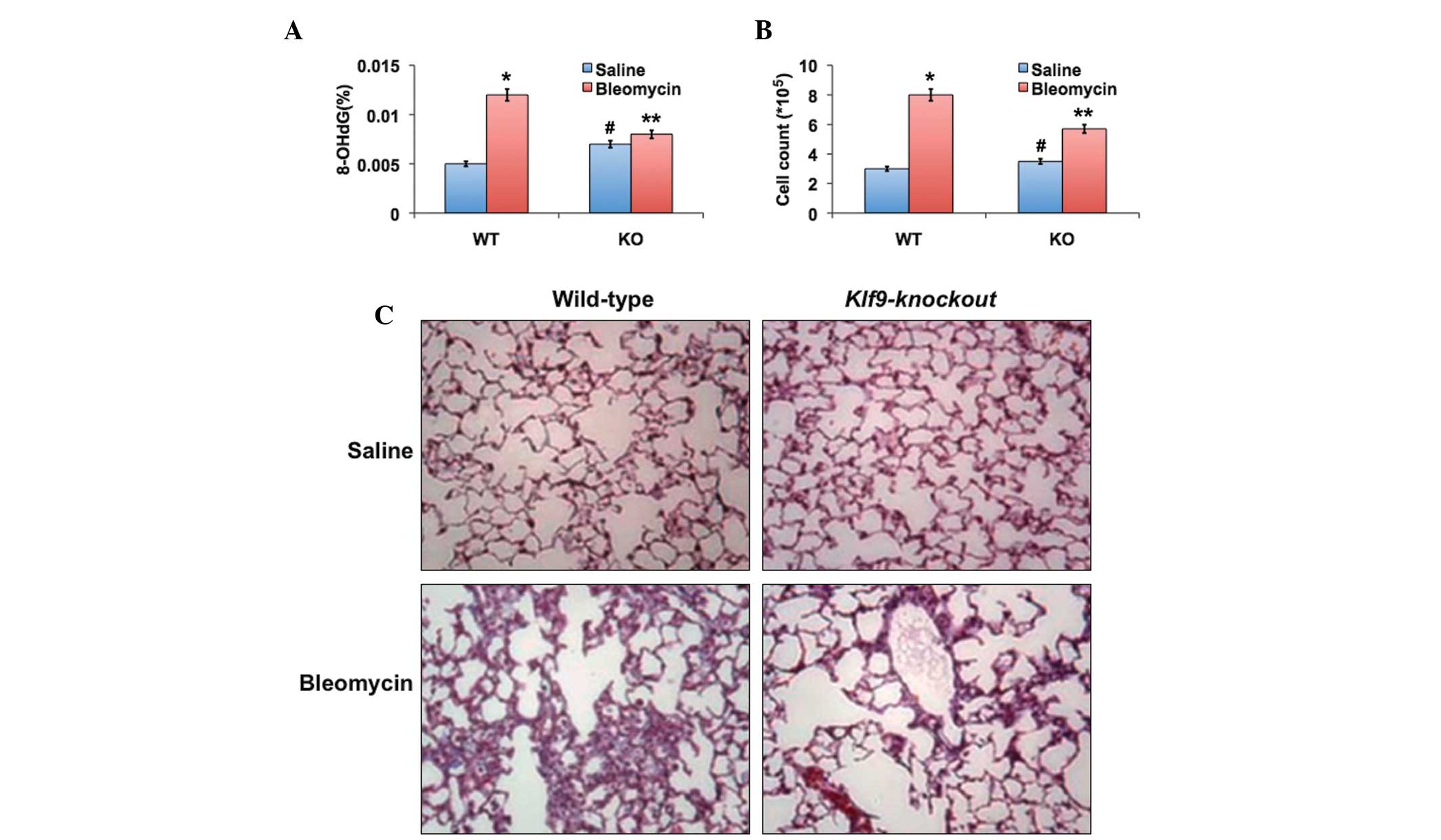Involvement of Kruppel-like factor 9 in bleomycin-induced pulmonary toxicity
- Authors:
- Published online on: July 2, 2015 https://doi.org/10.3892/mmr.2015.4015
- Pages: 5262-5266
Abstract
Introduction
Previous studies have suggested that alteration of oxidative stress and thiol-redox are initiating and propagating forces in the pathogenesis of bleomycin (BLM)-induced pulmonary fibrosis (1,2). BLM is an effective chemotherapeutic agent used primarily in the treatment of lymphoma, squamous cell carcinoma, testicular cancer and malignant pleural effusion (3). The antineoplastic effect of BLM is hypothesized to be due to the formation of a BLM-oxygen complex, which binds to the DNA and cleaves the phosphodiester-deoxyribose backbone (4). However, the effective clinical use of BLM in chemotherapy is limited as a result of the development of dose- and time-dependent interstitial pneumonitis, which eventually progresses to interstitial pulmonary fibrosis (5,6).
Oxidative stress in the cell is caused by an imbalance between the formation of free radicals and their removal by enzymatic and non-enzymatic anti-oxidant molecules (7). It was hypothesized that redox cycling of the iron-BLM complex catalyzes the formation of reactive oxygen species (ROS), which leads to an imbalance between ROS and the available anti-oxidant defenses, principally glutathione (8). The generated ROS damage lung cells and activate inflammatory cells, which accumulate in the lower airways and produce further ROS, leading to oxidative stress. The nuclear transcription factor, NF-E2-related transcription factor 2 (Nrf2), is a major sensor of oxidative stress in the cell (9). Under oxidative stress, Nrf2 is phosphorylated and translocated into the nucleus, where it activates the transcription of anti-oxidant and detoxifying genes by binding to the anti-oxidant response elements (AREs) in their regulatory regions (9).
A previous study investigating Kruppel-like factor 9 (Klf9) genes binding to the sequences of transcription factors in order to regulate the oxidative stress response, suggested that Klf9 promoter regions contained several conserved AREs (10), which are binding sites for Nrf2, a major regulator of anti-oxidant defense in the cell (9,11). Klf9 is a ubiquitously expressed member of the Sp1 C2H2-type zinc finger family of transcription factors (12). The expression of Klf9 can be increased by several stress-inducing agents, including the proteasomal inhibitor, bortezomib, and the histone deacetylase inhibitor, panobinostat, and Klf9 in turn mediates their cytotoxicity (13). Therefore, the present study aimed to investigate whether Klf9 was involved in the pathogenesis of BLM-induced pulmonary toxicity in human pulmonary fibroblasts (HPF), which was also analyzed in the Klf9 knockout mouse model.
Materials and methods
Cell lines and reagents
HPF cells, isolated from human lung tissue, were obtained from Promocell (Heidelberg, Germany). The cells were cultured in Dulbecco's modified Eagle's medium (Sigma-Aldrich, St. Louis, MO, USA), supplemented with 10% fetal calf serum (Gibco-BRL, Gaithersburg, MD, USA), 2 mM glutamine (Gibco-BRL), and penicillin-streptomycin antibiotics (Gibco-BRL). Hydrogen peroxide, sulforaphane, BLM, 2′-7′-dichlorofluorescin diacetate (DCFH-DA), actinomycin D and cycloheximide were purchased from Sigma-Aldrich.
Determination of cell viability and measurement of ROS
The HPF cells were seeded in a 96-well tissue culture plate, at a density of ~1.25×104 cells/well, for 24 h. The media was discarded and the cells were treated with various concentrations (25, 50, 100 or 200 µM) of BLM in serum-free media for 24 h. The levels of intracellular ROS generation were measured using a well-characterized probe, DCFH-DA. DCFH-DA is hydrolyzed by esterases to DCFH, which is trapped within the cell. This non-fluorescent molecule is subsequently oxidized to fluorescent DCF by the action of cellular oxidants. The cells treated with either BLM or standard media for 6 h were subjected to DCFH staining and the fluorescence was determined at 485 nm excitation and 520 nm emission, using a microplate reader (FLUOstar; BMG Labtech, Inc., Durham, NC, USA).
Protein expression levels of antioxidants
The harvested control and BLM-treated (50 or 100 µM) HPF cells were washed with ice-cold phosphate-buffered saline and were lysed with radioimmunoprecipitation buffer (Cell Signaling Technology, Inc., Danvers, MA, USA). The lysates were centrifuged at 10,000 × g for 10 min at 4°C, and the protein content of the supernatant was determined by the Bradford method (14). The proteins (10–20 µg) were loaded and separated by 10% SDS-PAGE and were blotted onto a polyvinylidene fluoride membrane (Thermo Fisher Scientific, Inc., Frederick, MD, USA). The membranes were blocked with 5% non-fat dry milk powder solution for 1 h at room temperature prior to overnight incubation with the following primary antibodies: Catalase (CAT; rabbit polyclonal; cat. no. ab87529; 1:500), glutathione reductase (GR; rabbit polyclonal; cat. no. ab137513; 1:500), super oxide dismutase (SOD; rabbit polyclonal; cat. no. ab16831; 1:2,000) and thioredoxin reductase 2 (TR-2; rabbit polyclonal; cat. no. ab71262; 1:500), all purchased from Abcam (Cambridge, MA, USA), and Nrf2 (rabbit polyclonal; cat. no. sc-722; 1:500) and Klf9 (rabbit polyclonal; cat. no. sc-28195; 1:500) were purchased from Santa Cruz Biotechnology, Inc. (Santa Cruz, CA, USA) at 4°C. Following rinsing of the membranes with Tris-buffered saline with Tween® 20, (Sigma-Aldrich), they were incubated with secondary antibody (goat anti-rabbit; polyclonal; cat. no. ab97200; 1:2,000; Abcam) for 1 h at room temperature and the bands were made visible by enhanced chemiluminescence using the SuperSignal West Femto substrate (Thermo Fisher Scientific, Inc.), visualized using the Alpha Innotech FluorChem HD2 Imaging system (Alpha Innotech Co., San Leandro, CA, USA). All antibodies, with the exception of α-tubulin (rabbit polyclonal; cat. no. ab4074; 1:1,000; Abcam), were used at a dilution of 1:250, and the α-tubulin antibody was used at a dilution of 1:1,000.
Gene expression analysis
Reverse transcription-quantitative polymerase chain reaction (RT-qPCR) was performed to analyze the gene expression status using gene-specific primers with the following sequences: Forward: 5′-ACAGTGGCTGTGGGAAAGTC-3′ and reverse: 5′-AACTGCTTTTCCCCAGTGTG-3′ for KLF9; and forward: 5′-AGTGGATCTGCCAACTACTC-3′ and reverse: 5′-CATCTACAAACGGGAATGTCTG-3′ for Nrf2. The total RNA was extracted from retinal cells using the RNA Nanoprep kit (Agilent Technologies, Santa Clara, CA, USA) and was reverse transcribed using the Reverse Transcription system (Promega Corporation, Madison, WI, USA) to synthesize cDNA. RT-qPCR was performed on the Rotor-Gene Q Cycler (Qiagen, Valencia, CA, USA) using the SYBR GREEN PCR Master mix (Qiagen). The data were analyzed using the 2−ΔΔCT method and amplification was performed for 2 min at 50°C and 10 min at 95°C, followed by 40 cycles of 95°C for 10 sec, 60°C for 10 sec, and 72°C for 30 sec. For each gene, the relative expression levels were calculated by comparison with a standard curve, following normalization to the expression of the housekeeping gene β-actin selected as a control.
Animal experiment
The animal experiments were performed, according to the ethical guidelines and were approved by the animal Ethical Committee of The First Hospital of Jilin University (Jilin, China). Thirty female KLF9 knockout mice and age-matched wild-type female mice (C57BL/6J; 14–16 weeks-old) were purchased from the Chinese Academy of Medical Science (Beijing, China). They were anesthetized and subjected to intratracheal instillation of saline or 2.5 mg/kg BLM sulfate saline solution (Sigma-Aldrich). The mice were euthanized via cervical dislocation 10 days following instillation and the content of 8-oxo-20-deoxy-guanosine (8-OHdG), a marker of oxidative DNA damage, was determined in the DNA isolated from the lungs of the treated animals.
Histopathological examination
At 19 days following intratracheal administration of BLM, the mice were euthanized and the lungs were inflated and fixed with 4% paraformaldehyde. The lungs were surgically resected and embedded in paraffin wax. Lung sections (5 mm) were cut and stained with hematoxylin and eosin. The stained sections were examined with a light microscope (Eclipse E100-LED; Nikon, Tokyo, Japan).
Statistical analysis
Data are presented as the mean ± standard deviation of triplicate experiments. Statistical significance was determined by one-way analysis of variance, followed by Tukey's multiple comparison tests. Analyses were conducted using Prism 5.0 (GraphPad Software, San Diego, CA, USA). P<0.05 was considered to indicate a statistically significant difference.
Results
Effects of BLM treatment
A dose-dependent increase in the production of ROS and cell death were observed in BLM-treated cells compared with the normal untreated cells (Fig. 1). The present study next investigated the levels of the anti-oxidant proteins, CAT, SOD, GR and TR-2, at 24 h in BLM-treated and control HPFs. The protein expression levels of Nrf2 and Klf9 were markedly increased at concentrations of BLM >50 µM (Fig. 2). However, with the exception of Nrf2 and Klf9, all other antioxidant proteins demonstrated a dose-dependent decrease in the expression levels (Fig. 2). To understand the mechanisms of the Klf9-mediated response to oxidative stress, the gene expression levels of Klf9 and Nrf2 were determined in the BLM treated cells. Similarly, gene expression analysis by RT-qPCR revealed that oxidative stress induced the mRNA expression levels of Nrf2 and Klf9 (Fig. 3). It was revealed that a 4- and 6-fold increase in the gene expression levels of Nrf2 and Klf9, respectively, occurred in the BLM-treated cells.
Effect of Klf9 deficiency on DNA damage and lung fibrosis
BLM treatment induced a statistically significant increase in the levels of 8-OHdG, a marker of oxidative DNA damage, in the lungs of wild-type mice (P=0.0003); however, it revealed no significant effect on the levels of 8-OHdG in the lungs of Klf9 knockout mice (Fig. 4A). A second cohort of saline- or BLM-treated mice were analyzed 19 days following treatment for the accumulation of cells in the bronchoalveolar lavage fluid (BALF) and for the accumulation of collagen, each of which are markers of lung fibrosis. A significant increase in the number of total BALF cells was observed in all animals treated with BLM (Fig. 4B). However, this increase was significantly lower in the Klf9 knockout mice compared with the wild-type counterparts (P<0.05). Fibrosis was observed in the histological lung sections stained with hematoxylin and eosin (Fig. 4C). No sign of fibrosis was detected in the wild-type or Klf9 knockout mice treated with saline solution. Treatment with BLM led to pulmonary fibrosis in the wild-type and knockout animals, although the degree of fibrosis was significantly higher in the wild-type mice compared with the knockout counterparts (P=0.038). Therefore, Klf9 deficiency provided resistance to BLM-induced oxidative stress and pulmonary fibrosis in mice.
Discussion
Due to the wide range of toxicities (pulmonary toxicity) associated with BLM (antineoplastic drug), clinical use is yet to be effective. Although several mechanisms have been hypothesized to explain BLM-induced pulmonary toxicity, there is clear evidence that ROS contribute to the pathogenesis of BLM-induced lung injury through several pathways (15–17). Pulmonary fibrosis is a chronic multifactorial disease, where oxidative stress is important in disease progression (18). In the present study, the transcription factor, Klf9, was assessed as a regulator of intracellular ROS in BLM-induced pulmonary toxicity. Klf9 is a ubiquitously expressed protein with a relatively understudied function. A significant, concentration-dependent increase in the total ROS was observed in the present study, indicating an increase in oxidative stress in response to treatment with BLM (Fig. 1). These data are in agreement with other previous studies, which have reported an increase in the production of ROS upon treatment with BLM (2,19). Antioxidant enzymes are involved in the detoxification or scavenging of oxidative free radicals in the cells. These results suggested that upon treatment with BLM, there is a significant reduction in the major antioxidant proteins, CAT, SOD, GR and TR-2, which are hypothesized to be an effective defense system in the lung. This indicated the excess generation of ROS (Fig. 2). This data is consistent with previous studies indicating that a decrease in antioxidant activity following BLM treatment indicated the formation of ROS, which, in turn, caused further damage to lungs (20–22). However, an increase in the expression levels of Nrf2 (23) and Klf9 upon treatment with BLM has also been reported (24).
The chemotherapeutic agent, BLM, has been demonstrated to cause oxidative lung injuries in mice, and BLM-treated mice are considered to be a classical model of idiopathic pulmonary fibrosis (25). Currently, only a few genes involved in the control of ROS have been implicated in the pathogenesis of pulmonary fibrosis in mouse knockout models (18), including Nrf2 as a sole transcription factor among these genes (12). Furthermore, Nrf2 was activated and its targets, including Nqo1, were upregulated in mice treated with BLM (23). Therefore, the functional involvement of Klf9, and potentially its targets, in the pathogenesis of pulmonary fibrosis uncovers a regulatory network of this disease and may offer targets and/or prognostic markers. The present investigation using Klf9 knockout mice clearly elucidated the reduced risk of ROS formation in lungs of BLM-treated mice. Since Klf9 depletion also suppressed oxidative stress, Klf9 downregulation may promote cancer progression and, potentially, resistance to the treatment. In conclusion, the data suggested that Klf9 is upregulated by Nrf2 under conditions of excessive oxidative stress, therefore, suggesting unique functions and modalities of the action of Nrf2 in the cell. These results are consistent with studies regarding the prognostic value of the expression of Klf9 in cancer and specifically Nrf2-regulated expression of Klf9. Investigations focusing on the involvement of Nrf2 and Klf9 are important for determining future therapeutic targets for BLM-induced pulmonary toxicity.
References
|
Karam H, Hurbain-Kosmath I and Housset B: Antioxidant activity in alveolar epithelial type 2 cells of rats during the development of bleomycin injury. Cell Biol Toxicol. 14:13–22. 1998. View Article : Google Scholar : PubMed/NCBI | |
|
Patel RB, Kotha SR, Sauers LA, Malireddy S, Gurney TO, Gupta NN, Elton TS, Magalang UJ, Marsh CB, Haley BE, et al: Thiol-redox antioxidants protect against lung vascular endothelial cytoskeletal alterations caused by pulmonary fibrosis inducer, bleomycin: Comparison between classical thiol-protectant, N-acetyl-L-cysteine and novel thiol antioxidant, N,N′-bis-2-mercaptoethyl isophthalamide. Toxicol Mech Methods. 22:383–396. 2012. View Article : Google Scholar : PubMed/NCBI | |
|
Lazo JS and Chabner BA: Cancer chemotherapy and biotherapy: principles and practice. Chabner BA and Longo DL: Philadelphia: Lippincott-Raven; pp. 379–394. 1996 | |
|
Hecht SM: Bleomycin: New perspectives on the mechanism of action. J Nat Prod. 63:158–168. 2000. View Article : Google Scholar : PubMed/NCBI | |
|
Chandler DB: Possible mechanisms of bleomycin-induced fibrosis. Clin Chest Med. 11:21–30. 1990.PubMed/NCBI | |
|
Keane MP, Belperio JA, Arenberg DA, Burdick MD, Xu ZJ, Xue YY and Strieter RM: IFN-gamma-inducible protein-10 attenuates bleomycin-induced pulmonary fibrosis via inhibition of angiogenesis. J Immunol. 163:5686–5692. 1999.PubMed/NCBI | |
|
Finkel T and Holbrook NJ: Oxidants, oxidative stress and the biology of ageing. Nature. 408:239–247. 2000. View Article : Google Scholar : PubMed/NCBI | |
|
Cross CE, Warren D, Gerriets JE, Wilson DW, Halliwell B and Last JA: Deferoxamine injection does not affect bleomycin induced lung fibrosis in rats. J Lab Clin Med. 106:433–438. 1985.PubMed/NCBI | |
|
Itoh K, Wakabayashi N, Katoh Y, Ishii T, Igarashi K, Engel JD and Yamamoto M: Keap1 represses nuclear activation of antioxidant responsive elements by Nrf2 through binding to the amino-terminal Neh2 domain. Genes Dev. 13:76–86. 1999. View Article : Google Scholar : PubMed/NCBI | |
|
Wasserman WW and Fahl WE: Functional antioxidant responsive elements. Proc Natl Acad Sci USA. 94:5361–5366. 1997. View Article : Google Scholar : PubMed/NCBI | |
|
Itoh K, Chiba T, Takahashi S, Ishii T, Igarashi K, Katoh Y, Oyake T, Hayashi N, Satoh K, Hatayama I, et al: An Nrf2/small Maf heterodimer mediates the induction of phase II detoxifying enzyme genes through antioxidant response elements. Biochem Biophys Res Commun. 236:313–322. 1997. View Article : Google Scholar : PubMed/NCBI | |
|
Kikuchi N, Ishii Y, Morishima Y, Yageta Y, Haraguchi N, Itoh K, Yamamoto M and Hizawa N: Nrf2 protects against pulmonary fibrosis by regulating the lung oxidant level and Th1/Th2 balance. Respir Res. 11:312010. View Article : Google Scholar : PubMed/NCBI | |
|
Mannava S, Zhuang D, Nair JR, Bansal R, Wawrzyniak JA, Zucker SN, Fink EE, Moparthy KC, Hu Q, Liu S, et al: KLF9 is a novel transcriptional regulator of bortezomib- and LBH589-induced apoptosis in multiple myeloma cells. Blood. 119:1450–1458. 2012. View Article : Google Scholar : | |
|
Bradford MM: A rapid and sensitive method for the quantitation of microgram quantities of protein utilizing the principle of protein-dye binding. Anal Biochem. 72:248–254. 1976. View Article : Google Scholar : PubMed/NCBI | |
|
Serrano-Mollar A, Closa D, Prats N, Blesa S, Martinez-Losa M, Cortijo J, Estrela JM, Morcillo EJ and Bulbena O: In vivo antioxidant treatment protects against bleomycin-induced lung damage in rats. Br J Pharmacol. 138:1037–1048. 2003. View Article : Google Scholar : PubMed/NCBI | |
|
Mastruzzo C, Crimi N and Vancheri C: Role of oxidative stress in pulmonary fi brosis. Monaldi Arch Chest Dis. 57:173–176. 2002. | |
|
Mata M, Ruiz A, Cerda M, Martinez-Losa M, Cortijo J, Santangelo F, Serrano-Mollar A, Llombart-Bosch A and Morcillo EJ: Oral N-acetylcysteine reduces bleomycininduced lung damage and mucin Muc5ac expression in rats. Eur Respir J. 22:900–905. 2003. View Article : Google Scholar : PubMed/NCBI | |
|
Cheresh P, Kim SJ, Tulasiram S and Kamp DW: Oxidative stress and pulmonary fibrosis. Biochim Biophys Acta. 1832:1028–1040. 2013. View Article : Google Scholar : | |
|
Sayed-Ahmed MM, Mansour HH, Gharib OA and Hafez HF: Acetyl-L-carnitine modulates bleomycin-induced oxidative stress and energy depletion in lung tissues. J Egypt Natl Canc Inst. 16:237–243. 2004. | |
|
Ali EN and Mansour SZ: Boswellic acids extract attenuates pulmonary fi brosis induced by bleomycin and oxidative stress from gamma irradiation in rats. Chin Med. 6:362011. View Article : Google Scholar | |
|
Iraz M, Erdogan H, Kotuk M, Yagmurca M, Kilic T, Ermis H, Fadillioğlu E and Yildirim Z: Ginkgo biloba inhibits bleo-mycin-induced lung fi brosis in rats. Pharmacol Res. 53:310–316. 2006. View Article : Google Scholar : PubMed/NCBI | |
|
Erdogan H, Fadillioglu E, Kotuk M, Iraz M, Tasdemir S, Oztas Y and Yildirim Z: Effects of Ginkgo biloba on plasma oxidant injury induced by bleomycin in rats. Toxicol Ind Health. 22:47–52. 2006. View Article : Google Scholar : PubMed/NCBI | |
|
Cho HY, Reddy SP, Yamamoto M and Kleeberger SR: The transcription factor NRF2 protects against pulmonary fibrosis. FASEB J. 18:1258–1260. 2004.PubMed/NCBI | |
|
Bieker JJ: Krüppel-like factors: Three fingers in many pies. J Biol Chem. 276:34355–34358. 2001. View Article : Google Scholar : PubMed/NCBI | |
|
Mouratis MA and Aidinis V: Modeling pulmonary fibrosis with bleomycin. Curr Opin Pulm Med. 17:355–361. 2011. View Article : Google Scholar : PubMed/NCBI |













